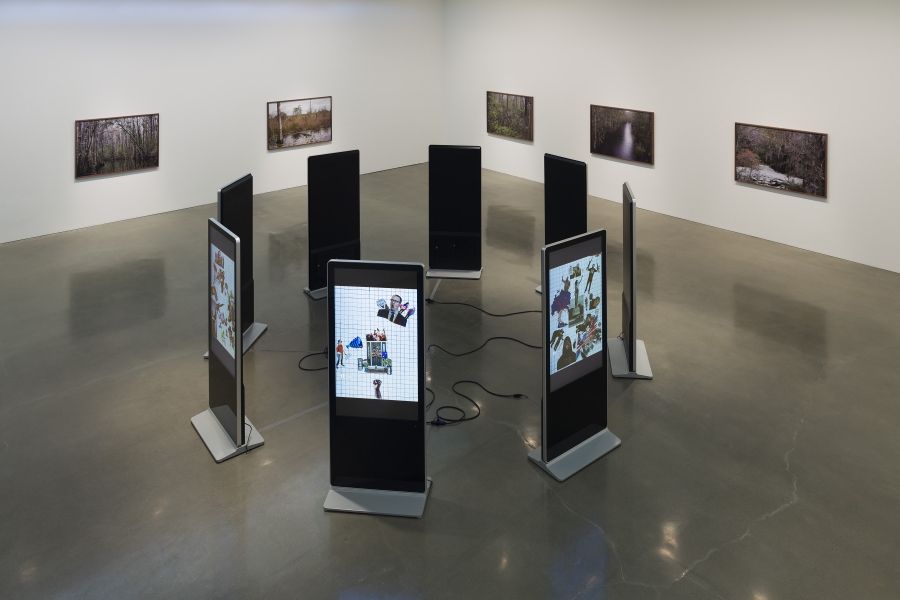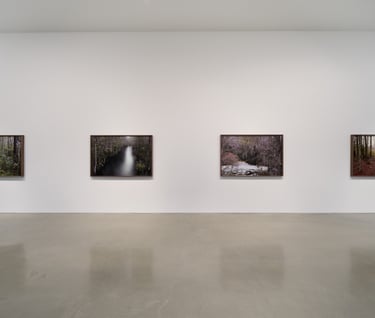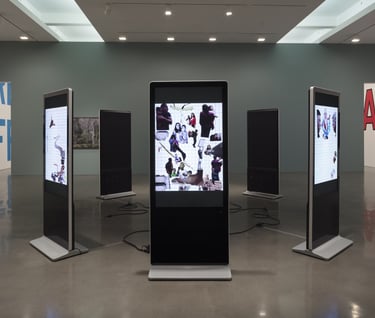Show Review: "Writing on the Bus: A Review of Catherine Opie's 'Rhetorical Landscapes'
Gracie Hadland
5/24/20205 min read


At a certain point in the career of a popular musician, an apex of decline is reached when the songwriting is all about being on tour and life on the road. It’s brought on by a comfortable success, after a period of transgression or rebellion; it’s the point at which the work becomes far less interesting (or maybe interesting for different reasons). The songs lament the slog of being on tour, about the empty feeling of writing on the bus, or in the hotel room, when the scrappy hustle that led to initial success has become dull and mundane. The record sales begin to dwindle but will always be somewhat steady. As evidenced in her most recent solo show at Regen Projects, which was one of the last that opened before everything closed, here, Catherine Opie, once our radical lesbian icon, seems to have found a comfortable post at which to recline.
The exhibition of new work, Rhetorical Landscapes, displays a series of photographs of Floridian swamps on the gallery’s walls surrounding 8 large monitors displaying digital animated collages. The monitors are a familiar kind of ugly, like giant iPhones or those charging kiosks. Or perhaps Opie, a Tesla owner herself, was inspired one day, while fueling up, by one of the many accommodating Tesla charging hubs in West LA. The collages on the screens compile appropriated images from the media; dictators, guns, American flags, crying children, those images that cause one to lament the state of the world.


While the swamp photographs demonstrate Opie’s skills as a seasoned photographer, well-printed, formally and technically intricate, the vast environments rendered in detail, they are bogged down by the heavy hand of their allusion to the political phrase “Drain the Swamp.” The phrase is one deployed by both Democrats and Republicans alike, the Swamp being the party establishment based in Washington DC, a landscape of swampy land, each party accuses the other of needing the drainage. Opie’s visual interpretation of the phrase seems to evade dealing with its political implications, rather suggesting how beautiful and calm swamps can be when captured as total environments. But rather than delving into their depths, where alligators lurk, Opie’s gaze remains on the surface. Opie told the LA Times, “At first, I thought I’d go in at night with a flash, then I realized how many alligators there were.” Flash would presumably expose things that are hidden by shadows or exist beneath the water. The photos reflect Opie’s superficial engagement with politics that lingers throughout the show. The political context they evoke gets swallowed up by the muddy mass, the message behind the work being just as murky as the swamps she photographs. In the same interview with the LA Times, Opie stated, “We have to ask ourselves what our relationship to vulnerability is and empathy and understanding — and a swamp contains all of that metaphorically.” Given the severe imagery of the collages on the screens just opposite the swamps, of global climate crisis, war, dictatorships, poverty, a message of vulnerability and empathy seems out of place, very much at odds with the images it faces. They’re on completely different planes, armed for completely different battles. Perhaps without knowing it, Opie has constructed a visual relationship that reflects the liberal vs conservative disconnect plaguing the current political climate. One approaches issues with hollow metaphors, vague ideas of hope and progress the material effects of which are unclear, while the other wields unchecked extreme power, greed, and corruption.


The animated assemblages of crying babies, Donald Trump, and seals panting on dwindling icebergs all share the tugging-at-your-heart-strings quality of images in an ASPCA commercial. Each monitor covers a different political subject — climate change, gun control, immigration. In crude animation, the images collect at the bottom of the screen and pile up on top of one another; this mishmash of clippings from “The News” reflects Opie’s tepid and vague politics. The images are reduced to banal meme-like visual sound bytes. There is no point really made here, and no political message to grab onto other than an amalgamation of all that is wrong with the world. What she intends to suggest about the state of the world, what kind of reaction she wants to rouse in the viewer is unclear. Rather she relies on a kind of liberal consensus, one that hates the Big Bad Man in the white house. In this way, the work fails to provoke any new questions, leaving issues unexplored and providing no outlet for conflict.
At a moment of media overload, articulation is more valuable than ever, to assert one’s political convictions without being corny and bombastic is essential. In such a polarized cultural and political climate, discourse is a productive mode in order for one to better understand her opposition, but this must be done tactfully. This work shares a similar attitude with those bumper stickers that say, “Anyone with a brain for president.” The generalized notion that anything is better than Trump suggests that this administration is a blip in the history of the world when it is pretty much consistent with the history of American politics. It brings into sharp relief the privileging of a sort of superficial and symbolic change that Boomers prioritize over actual structural change. With questions about “what it means to make art in a time of political turmoil” floating around the art world, privileged artists who make work about said political turmoil should be held to certain standards, expected to probe its source rather than throw it all together and call it a statement. A recent New York Times profile of the artist is titled “Catherine Opie’s Work is More Urgent Now Than Ever.” In the midst of a global pandemic spawned by political chaos and climate change that is hitting the US working class particularly hard I have to disagree with such a platitude. While photography can certainly be an influential tool for social change, it’s naive on the part of the cultural elite to think Opie’s photography is the antidote to the urgency of the political or climate crisis. Photography can’t save the world and if it could, I’m not sure these photos of swamps would not be the ones to do it.
Once seen as radical, Opie is best known for her early work that captured American subcultures of LGBTQ communities. She looked within and around her own community for inspiration producing portraits of butch lesbians and trans men. As part of this marginalized community she captured spaces or groups that have traditionally been outsiders. Often photographing BDSM culture and aesthetics, her work was a shock to the mainstream art world. But now Opie, the retired rockstar, is protected by the academy and her blue chip gallery, and a truly radical gesture is hard to come by. Perhaps, this is an unfortunate by-product of age or success, money specifically. Her photographs of queer sex were at the time transgressive and shocking. To formally document the aesthetics of this subculture was unique and exciting. Now she’s just writing on the bus.
